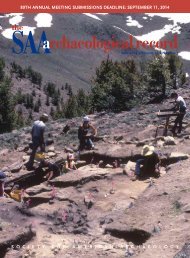SAA
Nov2016_web
Nov2016_web
Create successful ePaper yourself
Turn your PDF publications into a flip-book with our unique Google optimized e-Paper software.
VIDEO GAMES AND ARCHAEOLOGY<br />
field as the tools for its exploration become widely available.<br />
This availability is driving a new age of experimentation,<br />
increasingly undertaken by students whose status as digital<br />
natives allows them to intuitively merge interests in archaeology<br />
and virtual technologies. My own interest in this<br />
regard continues to focus on the technology’s potential for<br />
applied archaeology, and particularly the ways it can support<br />
social justice education (González-Tennant 2013). The rise of<br />
walking simulators in recent years demonstrates that a growing<br />
segment of the public are starved for nontraditional<br />
video games. This group seeks new experiences where selfexploration<br />
and novel forms of storytelling are central to the<br />
gaming experience. Archaeologists are in a powerful position<br />
to take advantage of this growth and to communicate<br />
the past to the public in immersive and interactive ways.<br />
Walking Simulators and Racial Violence<br />
Utilizing video games for applied archaeology, especially as<br />
it relates to difficult heritage, is not without its risks. Many<br />
still consider video games to be a childish form of entertainment.<br />
Not only is this false—the average age of most video<br />
gamers is over 30—a growing body of research demonstrates<br />
that video games are capable of eliciting strong emotional<br />
responses while simultaneously supporting the development<br />
of critical reasoning skills (Bogost 2011). Utilizing<br />
entertainment technologies to commemorate racial violence<br />
can run the risk of essentializing complex histories of disenfranchisement.<br />
This includes the creation of one-dimensional<br />
characters or reliance on worn-out tropes drawn from major<br />
motion pictures. These pitfalls are avoidable through the<br />
flexibility and power of video games, which supports wholly<br />
new ways of communicating difficult histories to a new generation<br />
in sensitive and thought-provoking ways. A successful<br />
example of this potential is illustrated with ongoing work<br />
in Rosewood, Florida.<br />
My exploration of archaeological walking simulators began<br />
in 2005 when I started researching Rosewood, Florida, home<br />
to a prosperous African American community that was<br />
destroyed in 1923 during a week-long episode of violence<br />
commonly referred to as the Rosewood race riot. In addition<br />
to documentary, ethnohistorical, and archaeological<br />
research, my ongoing work in Rosewood explores the use of<br />
virtual technologies to translate academic research into public<br />
knowledge. This includes the use of digital storytelling<br />
and the creation of a virtual world that reconstructs the vanished<br />
landscape of Rosewood. This virtual world remains<br />
one of the largest ever created by historical researchers and<br />
is available online at www.virtualrosewood.com. The current<br />
version of this virtual world recreates two square miles of<br />
Figure 3. View of original and updated structure from the Rosewood virtual<br />
world.<br />
landscape and includes nearly fifty structures representing<br />
homes, businesses, and public buildings (e.g., train depot,<br />
schoolhouse). While I was unaware of the term walking simulator<br />
when I began this project, my original virtual world is<br />
similarly focused on allowing users to freely explore the<br />
landscape. There are no non-player characters to interact<br />
with, nor any linear narratives to follow. Instead, users are<br />
able to learn about the town through the placement of historical<br />
signs at various points throughout the virtual world.<br />
I am presently updating the Rosewood virtual world, and<br />
many of my design choices are motivated by a serious<br />
engagement with walking simulators. At the center of this<br />
process is a desire to create a believable world. In support of<br />
this goal, I am literally (re)building the virtual world from<br />
the ground up. This begins with the incorporation of LiDAR<br />
data to create a physically accurate ground surface. It is a<br />
November 2016 • The <strong>SAA</strong> Archaeological Record<br />
25




